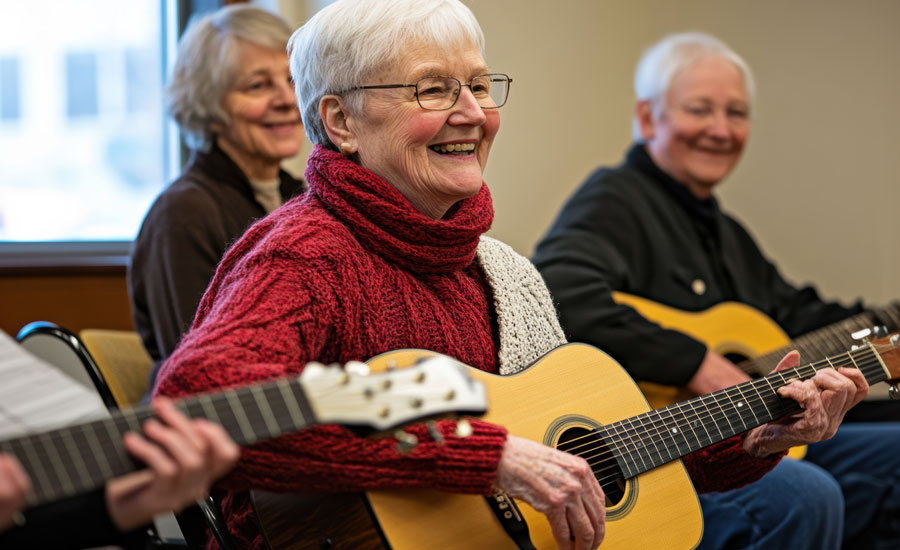Creative and Meaningful Activities in Care Homes and Why They Matter

A good care home makes sure life is enjoyable. The right activities can make a huge difference, keeping residents mentally sharp, physically active and emotionally connected.
In this blog, we’ll explore why creative activities are important, how they improve well-being and what to look for when choosing a care home that prioritises its residents’ happiness.
What are the Benefits of Music and Art in Care Homes?
Creative activities improve residents’ well-being in care homes in many ways, including:
- Music stimulates memory recall, particularly for dementia patients, reconnecting them with past experiences.
- Both music and creative projects have calming effects, lowering anxiety levels and promoting relaxation.
- Group activities like sing-alongs, painting and music therapy build new friendships and reduce loneliness.
- Residents who struggle with communication can express themselves much better through creative activities.
- Activities like painting, drawing or playing simple instruments help maintain hand-eye coordination and dexterity.
- Completing an art project or participating in a musical session gives residents a much-needed sense of achievement and boosts self-esteem.
- A care home filled with music feels more engaging, vibrant and uplifting for residents and staff.
Why Care Homes Need An Activity Schedule
Life in a care home should be engaging and fulfilling – alongside meeting basic needs.
A well-designed activity programme helps prevent boredom and loneliness, two of the biggest challenges older adults face. Whether it’s music, crafts, light exercise or social events, regular daily and weekly activities give residents something to look forward to and a reason to stay engaged with the world around them.
Activities like puzzles and memory games help keep the brain sharp, while movement-based sessions improve mobility and balance, reducing the risk of falls. Social activities encourage friendships, boost confidence and mental health, letting residents feel part of a community.
Most importantly, care home activities shouldn’t be one-size-fits-all. The best care homes customise activities to individual preferences, ensuring residents can participate in ways that suit their abilities and interests, creating meaningful moments that improve quality of life.
Popular Creative Activities in Care Homes
Let’s look at some of the most popular creative activities that brighten up a care home:
Music Sessions
There have been many studies on the benefits of music on older adults living in care homes. From live performances to sing-alongs with old favourites, music brings residents together, sparks memories and has the power to make everyone feel good. Even those who are usually quiet or withdrawn often find themselves tapping a foot or humming along to a familiar tune. It’s a simple joy that makes a big difference.
Arts and Crafts
Getting hands-on with paint, clay or even knitting needles is a fantastic way for residents to express themselves. It doesn’t have to be fancy – sometimes, the act of creating, no matter how simple, is incredibly satisfying. Plus, art sessions help maintain motor skills and give residents a sense of accomplishment. They get to show off their creations, bringing smiles all around!
Dance and Movement
You don’t need a dance floor to enjoy the benefits of movement. Gentle dance sessions or even seated exercises set to music means residents can stay active, improve coordination and, most importantly, have fun!
Storytelling and Drama
Residents have lived full lives and storytelling sessions allow them to share their experiences – or even create new ones. Group storytelling, drama workshops or reminiscing about the ‘good old days’ can start interesting conversations, laughter and a lot of bonding.
Gardening and Outdoor Activities
Sometimes, the best activities are those that connect residents with nature. Whether it’s planting flowers in a garden, tending to potted plants or just enjoying some fresh air, outdoor activities provide a change of scenery and a dose of sunshine. It’s refreshing and uplifting.
Personalised Activities in Care Homes
Not everyone enjoys the same things and a good care home acknowledges that. Some residents love group activities like singing sessions or quizzes, while others prefer one-on-ones or alone time, such as puzzles, listening to music or quiet chats over a cup of tea.
Physical ability matters too. A former dancer might not be able to move like they used to, but they can still enjoy music and rhythm in a seated session. A keen gardener with mobility issues might love potting plants or sharing tips with others. The aim is to adapt activities so everyone can take part in a way that works for them.
Families play a big role in this. During care plan development, care homes will ask about a resident’s past hobbies, things like baking, painting or listening to the radio, so they can create activities that feel familiar and personal.
Activities That Make a Difference
Care home activities should bring purpose, connection and enjoyment to daily life. Creative sessions are incredibly engaging, allowing residents to be themselves and feel part of a community.
When choosing a care home, watch how residents take part. Do they look engaged? Are activities suited to different abilities and interests? A home that gets this right will always provide better care and a richer quality of life.
Ready to explore...
